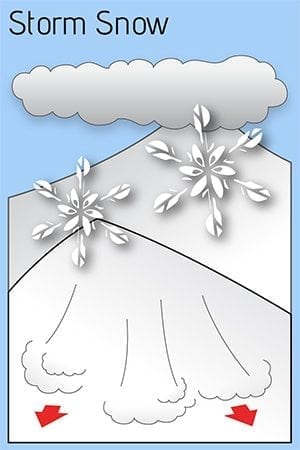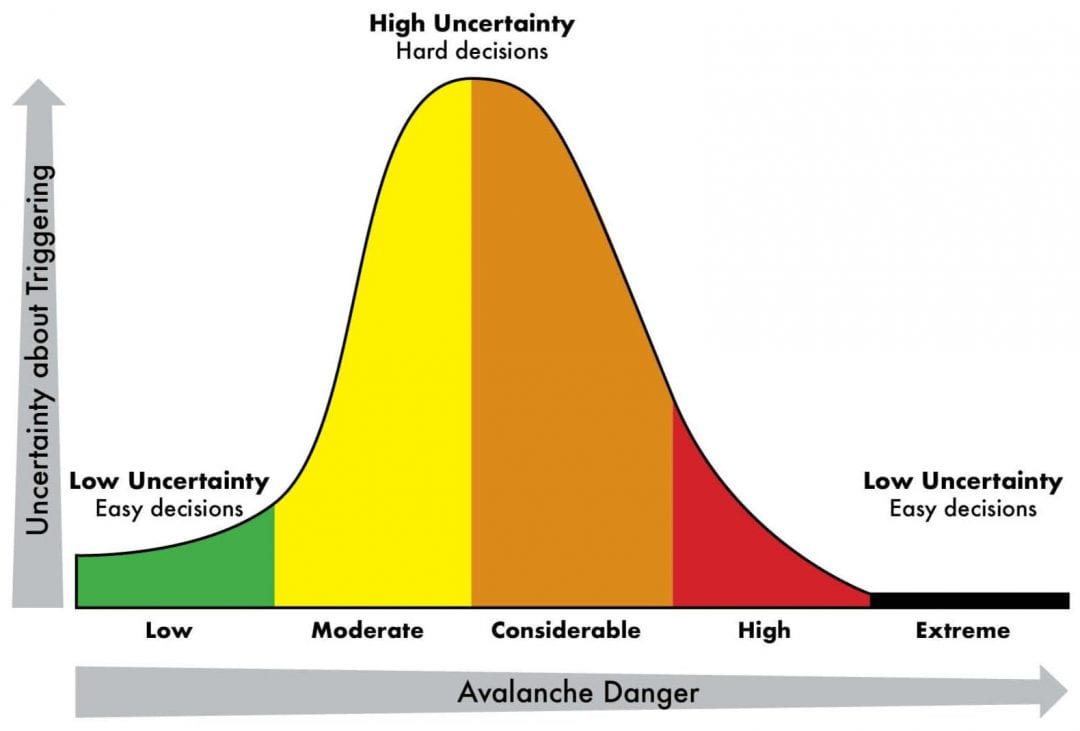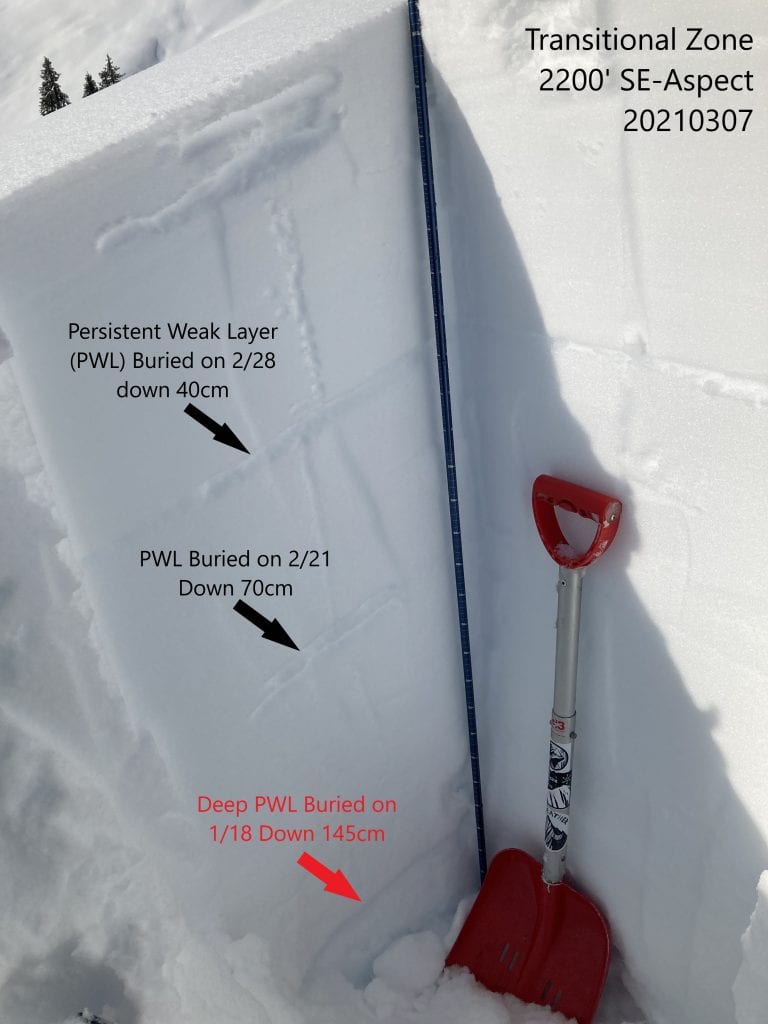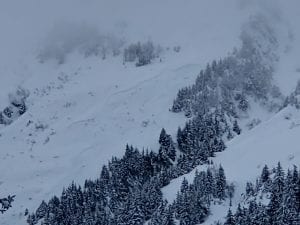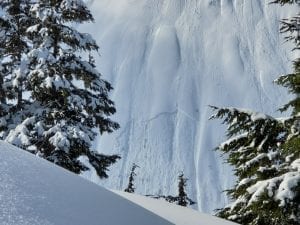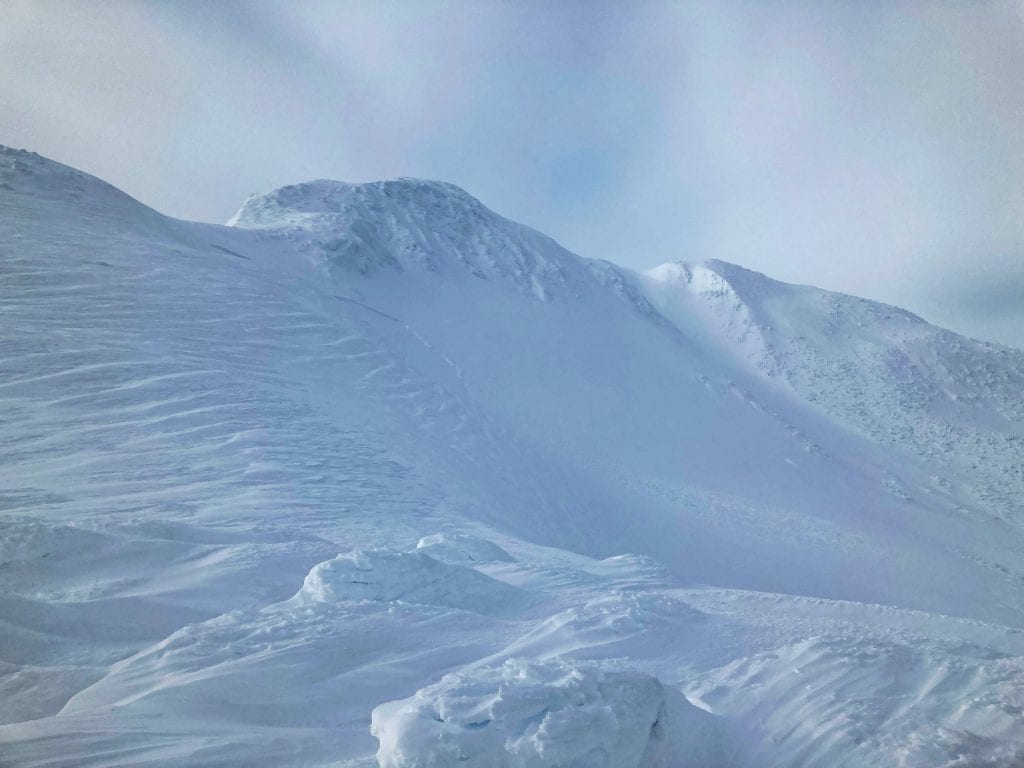Haines Avalanche Center
Above 2,500ftConsiderable
1,500 to 2,500ftConsiderable
Below 1,500ftConsiderable
Degrees of Avalanche Danger
Avalanche Problems
Problem 1
Confidence: High. Distribution: Widespread, especially wind loaded NW-N-NE-E aspects. Reactiveness: Touchy.
The last few days brought 20-40″ of new storm snow, and it came in upside-down. This means that the new snow is weak underneath and quite prone to failure. Avoid slopes 30 degrees and steeper, where Human triggered avalanches remain likely. This new snow needs a little more time to heal and bond.
If you venture into avalanche terrain, reduce your exposure by travelling one-at-a-time across suspect slopes, and be mindful of any terrain traps below you where all this new snow can pile up extremely deep.
Any slides in the upper snowpack are likely to step down to deeper weak layers in the midpack. See the Deep Slab problem below…
Likelihood:
- Almost Certain
- Very Likely
- Likely
- Possible
- Unlikely
Size:
- Historic
- Very Large
- Large
- Small
Trend
- Increasing
- Steady
- Decreasing
Problem 2
Confidence: Low. Distribution: Widespread. Reactiveness: Stubborn.
Given the large amounts of new storm snow, and known weak layers in the mid pack and below, you will need every tool in your toolbox:
- Identify and avoid suspect wind loaded slopes
- Most likely to trigger a slab from a shallow part of the slope
- Look at the full avalanche path, identify starting zones
- Surface instabilities are over deeper buried PWL‘s
- Increased wind slab hazard adds overall complexity
- Use extra caution traveling below run-out zones
We currenlty have three buried persistent weak layers:
- Near-surface facets (NSF) & surface hoar down 70-90cm from March 11th
- Buried surface hoar & melt-freeze crust / facet combo down 130cm from February 28th
- Melt-freeze crust or facet combo down 160cm from February 21st
Persistent weak layers below wind slab closer to the surface will be reactive or touchy for human triggered avalanches. Persistent layers in the mid-pack likely are to behave stubbornly, or unreactive.
- The location of these weak layers are difficult to map and highly elevation and aspect dependent.
- Glacier effect and valley effect are two contributing factors to where surface hoar has developed
- Freezing levels have shaped where hard crusts and facets combinations have formed.
- Sheltered terrain = protected areas where weak layers are buried.
- Solar aspects are warming in the spring sun and have especially poor structure.
- Consider underlying terrain such as alder, trees, rocks, and cliffs as suspect trigger points.
- Bigger triggers such as cornice collapse, snowmachine drops, or accessing thin areas of the slab.
- Sunlight weakens surrounding snow and those are areas you more likely could trigger an avalanche from.
Again, remember your tool box to reduce risk and travel safely:
- Slope angle is as important as ever when traveling through avalanche terrain, as well as slope failure consequences like terrain traps or group spacing.
- Only expose one person to a slope at a time and carefully identify run-out zones, starting zones, defined paths and non-defined paths.
- Beware of the familiarity heuristics “this slope never slides” as the snowpack is not giving us positive feedback for getting lucky.
- Expect avalanches to break wider and run longer than expected, keep your safety margins very wide.
- Stick to slopes that are below 30 degrees without steeper slopes connected above, or where tree spacing and anchoring are tight enough to anchor a slab.
The layers seen in the image below are all now buried beneath 50-80cm of new storm snow.
Finally, we have Two DEEP persistent weak layers:
- MLK day facet crust/combo down ~200cm+ buried on 1/18 is widespread on terrain near and below 3000′.
- November depth hoar down ~400cm in specific very steep, exposed, high alpine terrain.
Deep Slabs require either a heavy trigger, like cornice falls and snowmachine drops. Or an avalanche in the upper layers of the snowpack that steps-down. You are also more likely to initiate a fracture from the thinnest part of the slope into a much thicker part. Think about how wind distributes snow to thin and fat zones.
These deepest weak layers have been unreactive, or very stubborn but do exist in the landscape. Continued load such as settlement, wind, new snow, rain, or rapid temperatures changes will increase the hazard. Any slabs that break this deep are likely to be deadly. South aspects are known to have poor structure and are getting baked by strong solar radiation when the sun comes out, which weakens the snowpack. Upper persistent slab avalanches could step down, release sympathetically, or remotely trigger deeper layers (see Persistent Slab above).
We are in the most deadly time of year in Haines. Early March has historically brought tragic accidents with large avalanches that break much wider than expected.
Likelihood:
- Almost Certain
- Very Likely
- Likely
- Possible
- Unlikely
Size:
- Historic
- Very Large
- Large
- Small
Trend
- Increasing
- Steady
- Decreasing
Weather
Last weekend was calm and very cold with strong NW winds. This week brought a heavy storm cycle with 1.5-3.5″ of new SWE (20-40″ of new snow). Snow showers will taper off Friday, leading to some clearing Saturday. The next storm comes in Sat. night – Sunday with low snow levels and light to moderate accumulations.
| Snow Depth [in] | Last 24-hr Snow/SWE [in] | Last 3-days Snow/SWE [in] | Today’s Freezing Level [ft] | Today’s Winds | Next 24-hr Snow/SWE | |
| Mount Ripinsky @ treeline | 140″+* | 4″ / 0.35* | 31″ / 2.85* | 0′ | light-mod, N | 1″ /0.10* |
| Flower Mountain @ treeline | 113″ | 3″ / 0.20 | 20″ / 1.70 | 0′ | light-mod, N | 1″ /0.10* |
| Chilkat Pass @ 3,100ft | 59″ | 2″ / 0.15 | 7″ / 0.40 | 0′ | light-mod, N | 0″ /0.00* |
( *star means meteorological estimate )
—The Mt. Ripinsky weather station is completely buried and no longer reporting.—
Additional Information
Practice like you play. Make sure all your rescue gear it is fully functional and your beacon has full batteries. Make sure 1) everyone in the group has a functioning beacon, shovel and probe 2) knows how to use them and 3) has trained in companion rescue in the last year. Keep your skills fresh. If you head into the hills, watch out for red flag avalanche conditions, natural avalanches, whoomphing or collapsing, and shooting cracks.
Education Video Links:
- AIARE
- How to Practice Avalanche Rescue Snowmobile Edition: https://youtu.be/2ML499MMDfM
- AK Sled Shed Motorized Learning:
- Intro: https://youtu.be/aoagKHfGkxs
- Personal Electronics in Avalanche Terrain: https://youtu.be/2Vz9S0OEyFk
- Snowmobile Macgyver Tool Kit: https://youtu.be/4WBNu_t6Bbk
- Head and Face Protection: https://youtu.be/jIzW89wOyZI
- Pre-season prep: https://youtu.be/zJmrb8cZlR4
- My Transceiver: https://youtu.be/yblaDWP7Jf8
- BCA Avalanche Safety for Snowmobilers
- How to Fix Common Snowmobile Problems in the Field: https://youtu.be/g9fiTxEvuFk
- Sleducation: Avalanche Safety for Snowmobilers: https://youtu.be/EWFOd_9DYb8
- Intro to Avalanche Transceivers for Snowmobilers: https://youtu.be/6ZLSBmsceog
- Avalanche Transceiver Trailhead Test for Snowmobilers: https://youtu.be/rWoXbadFBsY
- Avalanche Transceiver Searching Use Snowmobiles: https://youtu.be/w1ucyI6LMXM
- BCA Avalanche Rescue Series
- Beacon Search 101: https://youtu.be/nnHXLVA2FcE
- Avalanche Probing 101: https://youtu.be/-0_yDN5Drzw
- Avalanche Shoveling 101: https://youtu.be/dGQg9o3vAkM
- Organizing a Backcountry Rescue: https://youtu.be/gywtmukgt8s
- Post Avalanche Patient Care: https://youtu.be/9FyIeUy4wpQ
- Backcountry Evacuation: https://youtu.be/WPF-dciefL8
- Complex Multiple Burials Backup Techniques: https://youtu.be/pB6AfY2KyYo
- National Avalanche Center
- Avalanche Problems Explained: https://youtu.be/DkbnT_9-cHU
- Intro to North American Avalanche Danger Scale: https://youtu.be/r_-KpOu7tbA
Alerts
Click the + Full Forecast link below for each zone to read more. BOTTOM LINE THIS WEEKEND: Hazardous conditions exist. We still have a complex snowpack, keep your safety margin wide. Heavy recent snowfall is adding stress to buried weak layers. Solar radiation weakens snow and can trigger avalanches naturally.
